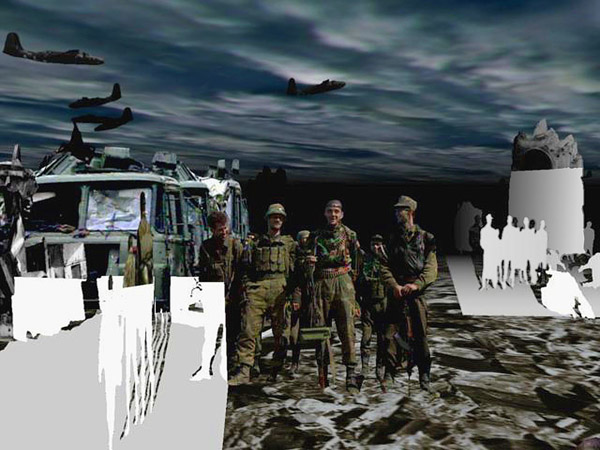‘World Skin’ is an immersive, interactive virtual reality installation. It’s a CAVE installation which features a three-dimensional landscape made up out of photographs and news pictures from different zones of war. Visitors thus enter a universe filled with violence. The audio reproduces the sounds of breathing. Because in this world, to breathe is to suffer.
When entering the CAVE, visitors are equipped with cameras and become war tourists. Only one visitor can “drive” using a “wand”. He/she takes over the role of a “bus driver”, but everyone can ask about path alterations.
Visitors can take pictures, but in this virtual reality photography is a weapon of erasure. When you take a picture of a fragment of the virtual world, this fragment disappears from the screen and will be replaced by a blank silhouette. Each picture, therefore, extinguishes a part of the world and is printed out for the visitors to take home. So taking a picture in this CAVE means literally “taking” something with you and making it your own. You rip of the skin of the world you are visiting, and you can take it with you as a personal trophy.

War is a world filled with pain. Through the media, war can become a public space in which this pain can be exposed. Without this exposure, people from lands without war feel like they cannot get a grasp of the world around them. But can a picture take us closer to reality? Maurice Benayoun seems to suggest the contrary: “One “takes” the picture, and the world “proffers” itself as a theatrical event. The world and the destruction constitute the preferred stage for this drama-tragedy as a play of nature in action.” [1]
We could actually see this artwork-simulation as a critique on the concept of ‘Simulations and Simulacra’ as formed by Jean Baudrillard. Baudrillard, in writing about simulations, believes that there is no ‘real’, no ‘truth’. He writes: “the simulacrum is never that which conceals the truth–it is the truth which conceals that there is none. The simulacrum is true.” [2] This artwork seems to suggest that there is in fact a reality, a reality that could be hurtful.
Jeffrey Shaw states in his article ‘Movies After Film – The Digitally Expanded Cinema’ that the holy grail in all forms of art is: “presence, the experience of being in that place that induces a totality of engagement in the aesthetic conceptual construct of the work”. [3] Shaw’s ‘conFiguring the CAVE’ is one of the most important works to be created using the CAVE in the mid-1990s. He suggests that this work was a “totally immersive experience for the viewers”. [4]
‘World Skin’ also uses the CAVE. However, this artwork seems to comment on the notion of ‘immersion’ in a different way. Although the visitors of this virtual reality feel as if they are immersed in this war-environment, they can never know what it’s like to really live in such a universe of violence; as tourists, they can never fully immerse themselves in the everyday realness of the men, women and children who do live in these worlds. Maurice Benayoun explains: “Some things cannot be shared. Among them are the pain and the image of our remembrance. The worlds to be explored here can bring things closer to us – but always simply as metaphors, never as a simulacrum.” [5]
Notes:
[1] Maurice Benayoun: http://www.benayoun.com/projet.php?id=16
[2] Jean Baudrillard, Selected Writings, ed. Mark Poster (Stanford; Stanford University Press, 1988): p. 166.
[3] Shaw: ‘Movies after film-The Digitally Expanded Cinema’ (2002). In: Edward Shanken, red. Art and Electronic Media. London: Phaidon, 2009: p. 264.
[4] Ibid.
[5] Maurice Benayoun: http://www.benayoun.com/projet.php?id=16
